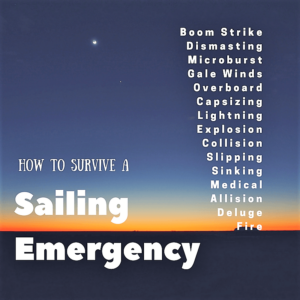Every summer, Category 3 hurricanes along the East Coast inspire anxiety among sailors. In describing how to survive a sailing emergency, these are ranked not by worst-case at the top because all of them are bad scenarios.
Instead, they are ranked by degree of likelihood-to-happen, with the top categories representing the least likely and the bottom categories more likely. Each item is followed by a suggestion. In all cases, crew should be familiar with how to use Marine radio Channel 15 to hail help by announcing “Mayday! Mayday! Mayday!” (See video below.)
-
Lightning
This isn’t the worst thing that could happen, only the most remote. Typically a lightning strike hits the top of the mast when you’re out in open water with nothing higher to attract the zap. While the accompanying thunder can make a big noise, the strike itself goes into the salon of the boat where it fries the electronics. This will not impair your ability to return to port.
How to survive: Make sure the skipper shows you where the fire extinguishers are in case the zapping of the electronics leads to a fire in the cabin. Let’s Go Sail’s experience is that lightning is more likely to strike a docked boat in a marina because of electrical charges that accumulate in the water (from defective shore cords). Here is a video of one of the most recent port strikes, near South Boston MA. It’s enough to make you take up bowling.
-
Capsizing
 It takes a lot to turn a sailboat upside down permanently, since even the worst knockdown will let a keel boat bounce back up. But it can happen on boats with swing keels or pull-out centerboards. Neither keel is heavy enough to keep the boat on, so to speak, an even keel. Most sailboats over 25 feet have a fixed lead keel that will absolutely prevent capsizing. Thousands of pounds below the water line offer excellent ballast that prevents overturning.
It takes a lot to turn a sailboat upside down permanently, since even the worst knockdown will let a keel boat bounce back up. But it can happen on boats with swing keels or pull-out centerboards. Neither keel is heavy enough to keep the boat on, so to speak, an even keel. Most sailboats over 25 feet have a fixed lead keel that will absolutely prevent capsizing. Thousands of pounds below the water line offer excellent ballast that prevents overturning.
How to survive this sailing emergency: If you’re in a sailboat 15-20 feet long that capsizes, stay with the boat and do not attempt to swim to shore. Generally you’re boating in narrowly contained waters and will be seen by someone shortly for rescue. Let’s Go Sail has a keel of 4,000 pounds under a boat that otherwise weighs 5,000 pounds.
-
Microburst
This is also known as wind shear, in which a blast of air swoops down on the boat and virtually presses it downward into the water. A microburst is sometimes visible as a waterspout, i.e. a small tornado on the water. If you get caught in one, the force of the wind can shred the sails in seconds.
How to survive this sailing emergency: Avoid getting near waterspouts and motor away from them if possible. Go below into the cabin and wait out the event. Waterspouts are seen rarely on Chesapeake Bay, never on the York River where Let’s Go Sail cruises. If you sense one coming, drop the sails quickly and tie them off.
-
Squall/Gale
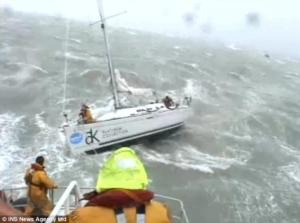 Any wind of 32 mph and up is capable of churning up big seas. Large wave troughs of 6-10 feet make it difficult to navigate in any but the biggest sailboat. Look for building seas by watching for an incremental increase in whitecaps.
Any wind of 32 mph and up is capable of churning up big seas. Large wave troughs of 6-10 feet make it difficult to navigate in any but the biggest sailboat. Look for building seas by watching for an incremental increase in whitecaps.
How to survive this sailing emergency: Ascertain from the captain if the boat can take the beating. If it can, which is likely, and then brace yourself and try to stay low in the boat cockpit to avoid getting knocked around. Let’s Go Sail is good up to 7-foot waves, but they are found in the Chesapeake Bay instead of the York River. In 2019 we got caught in a squall line near R-24 and had to ride it out over a 3-minute span that was pretty harrowing for the unsuspecting family on board. They did fine.
-
Deluge
Gale force winds can be accompanied by a deluge of rain. Again, make sure the boat can take it. Close the cabin doors to seal off the salon.
How to survive: You may or may not care to go below. If you’re properly dressed to stay dry, you’ll be fine. Try not to move around much, to avoid slipping on the deck. Hang on to whatever you can find that’s sturdy, including each other.
-
Explosion
This usually results from gasoline fumes building up in the bilge of a sailboat over several days. Any electrical charge can set it off. For this reason, all modern sailboats operate today on diesel because it has a much safer burn point and fewer dangerous fumes. Let’s Go Sail has an 18 hp Yanmar diesel.
How to survive: During the safety briefing, be sure to find out where the fire extinguishers are so you can grab one.
-
Fire
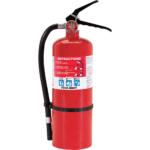 An explosion can lead to fire, and fire can also break out from discarded cigarettes and other flammables. Competent captains are zealous about minimizing any clutter or other hazards that could lead to fire. Lightning can also lead to fire, though the video above doesn’t seem to show a lingering blaze.
An explosion can lead to fire, and fire can also break out from discarded cigarettes and other flammables. Competent captains are zealous about minimizing any clutter or other hazards that could lead to fire. Lightning can also lead to fire, though the video above doesn’t seem to show a lingering blaze.
How to survive this sailing emergency: Resist the temptation to jump overboard. Instead, grab a fire extinguisher and aim for the base of the blaze — not the center or top. Let’s Go Sail has two fire extinguishers strategically deployed inside and outside the cabin for quick action.
-
Sinking
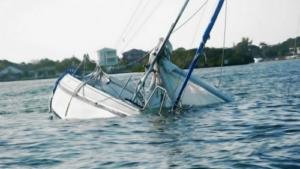 The common cause of sinking is running aground on rocks that penetrate the hull below the water line. Less common is when a thru-hull for water intake or drain is defective and falls out of the boat.
The common cause of sinking is running aground on rocks that penetrate the hull below the water line. Less common is when a thru-hull for water intake or drain is defective and falls out of the boat.
How to survive: Ask the skipper what the likelihood is and whether the boat has chocks and plugs handy at the thru-hulls. Let’s Go Sail has five wooden chocks and a big rubber cone plug. What’s more, we are at less risk because there are few rocks below in the York River, just sand and mud.
-
Collision
Boats run into each other, it happens. Usually it’s a glancing blow at a turn in a race or a driveby to impress someone.
How to survive: If it’s a head-on or T-bone crash, brace yourself for a sudden stop. Keep your center of gravity low. Hang onto something tight. Afterward, assess the damage to see if there is any threat to life or boat.
-
Allision
This obscure term refers to a moving ship hitting a fixed object such as an anchored vessel or a day mark. The effect is the same as a collision, but with only half the momentum of a head-on.
How to survive: Keep your eyes peeled to make sure that whoever in on the helm is paying attention. Learn how to spot a pending allision by using the Constant Bearing Decreasing Range technique. It’s easy, clever and foolproof.
-
Dismasting
An allision can tear the wire shrouds off the boat by breaking them under stress. If all the shrouds go out on one side or the other, the mast will fall down.
How to survive this sailing emergency: The mast will drop in a second or two like a felled tree, so you have a moment to anticipate where it will land. Don’t just look at it, get out of the way. If it’s coming at you regardless, brace your arms overhead.
https://www.youtube.com/watch?v=8R-_iFneJP8
-
Boom Strike
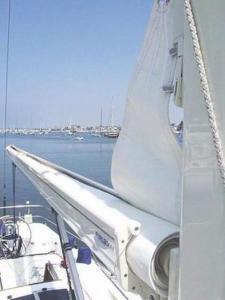 This sometimes happens when the helmsman tacks from one side to the other in a turn. As the boom crosses, it can knock someone in the head if they’re not paying attention. Depending on the tack, it can be quite a blow but probably not enough to knock them out. If the boat gibes accidentally instead of tacks, the boom can strike three times as fast and knock someone right out of the boat. Many modern sailboats of 30 feet and longer are built with booms that have 6-feet-4 of clearance, which is sufficient for all but the basketball players on board.
This sometimes happens when the helmsman tacks from one side to the other in a turn. As the boom crosses, it can knock someone in the head if they’re not paying attention. Depending on the tack, it can be quite a blow but probably not enough to knock them out. If the boat gibes accidentally instead of tacks, the boom can strike three times as fast and knock someone right out of the boat. Many modern sailboats of 30 feet and longer are built with booms that have 6-feet-4 of clearance, which is sufficient for all but the basketball players on board.
How to survive: Before departing, size up your height to that of the boom clearance. As the boat turns, sit down. If you’re standing, get ready to duck. If you do get hit, pay special attention to the effects of a concussion (dizziness, headache, loss of consciousness, confusion, nausea). Apply an ice pack.
-
Overboard
Albeit rare, unlucky No. 13 is the most frequent genuine catastrophe you will encounter on the water. It results from falling over the side of the boat into unsuspecting waters that may be quite cold.
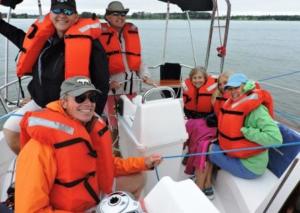 How to survive: Pay attention to the Man Overboard drill given by the captain. This is a precise operation requiring a Figure 8 return to the victim. Throw cushions to him or her, but not until you get near. Be willing to help with a throw rope or to toss a horseshoe life preserver. Wear a life preserver yourself. Let’s Go Sail issues USCG Class I personal floatation devices. In the event someone goes overboard, do NOT let anyone else jump in, especially mothers trying to rescue their children. One person in the water is plenty, and the captain should be able to get to the lone victim within a few minutes. If you are the one who has fallen overboard, move into the fetal position to preserve body heat. Resist the inclination to thrash and wave your arms. We see you.
How to survive: Pay attention to the Man Overboard drill given by the captain. This is a precise operation requiring a Figure 8 return to the victim. Throw cushions to him or her, but not until you get near. Be willing to help with a throw rope or to toss a horseshoe life preserver. Wear a life preserver yourself. Let’s Go Sail issues USCG Class I personal floatation devices. In the event someone goes overboard, do NOT let anyone else jump in, especially mothers trying to rescue their children. One person in the water is plenty, and the captain should be able to get to the lone victim within a few minutes. If you are the one who has fallen overboard, move into the fetal position to preserve body heat. Resist the inclination to thrash and wave your arms. We see you.
-
Slip & Fall
While not necessarily a catastrophe, slipping and falling incidents can constitute a medical emergency. The danger of slipping is that you fall and hit your head on something. Modern sailboats have an inlay deck with a mesh pattern that diminishes slipping. Let’s Go Sail uses a special resin on this non-skid surface to improve adherence.
How to survive: Try not to move around the boat in the first place. Whenever descending stairs to the salon or the dock, go down backward as if you’re on a ladder.
-
Medical

